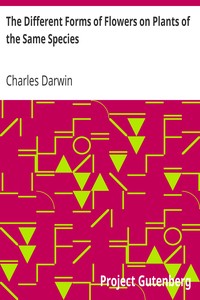| Author |
Darwin, Charles, 1809-1882 |
| Title |
The Different Forms of Flowers on Plants of the Same Species
|
| Note |
Reading ease score: 57.8 (10th to 12th grade). Somewhat difficult to read.
|
| Credits |
Sue Asscher and David Widger
|
| Summary |
"The Different Forms of Flowers on Plants of the Same Species" by Charles Darwin is a scientific publication written during the late 19th century. The book examines the variations in flower structures among plants of the same species, particularly focusing on the concepts of heterostyly, where plants exhibit different forms of flowers that affect their reproductive strategies. This work extends Darwin's earlier discussions on floral diversity and sexual reproduction in plants, detailing the mechanisms that promote cross-fertilization and hybridization. At the start of the book, Darwin introduces the key subject of plant flower variation, indicating that his observations stem from prior research and discussions within botanical circles. He notes the significant differences between flower forms, such as in primroses and cowslips, where features like the length of pistils and stamens play crucial roles in reproduction and fertility. The opening sets the tone for the subsequent chapters, which delve into specific case studies and empirical data illustrating how these floral structures facilitate or hinder successful pollination and seed production, underscoring their evolutionary implications. (This is an automatically generated summary.)
|
| Language |
English |
| LoC Class |
QK: Science: Botany
|
| Subject |
Plants -- Variation
|
| Subject |
Fertilization of plants
|
| Subject |
Heterostylism
|
| Subject |
Plant physiology
|
| Subject |
Pollination
|
| Category |
Text |
| EBook-No. |
3807 |
| Release Date |
Mar 1, 2003 |
| Most Recently Updated |
Jan 3, 2022 |
| Copyright Status |
Public domain in the USA. |
| Downloads |
121 downloads in the last 30 days. |
|
Project Gutenberg eBooks are always free!
|

